文様説明
-Pattern description-和柄には文様によって様々な意味を持っています。ここではそんな文様のご紹介をしたいと思います。
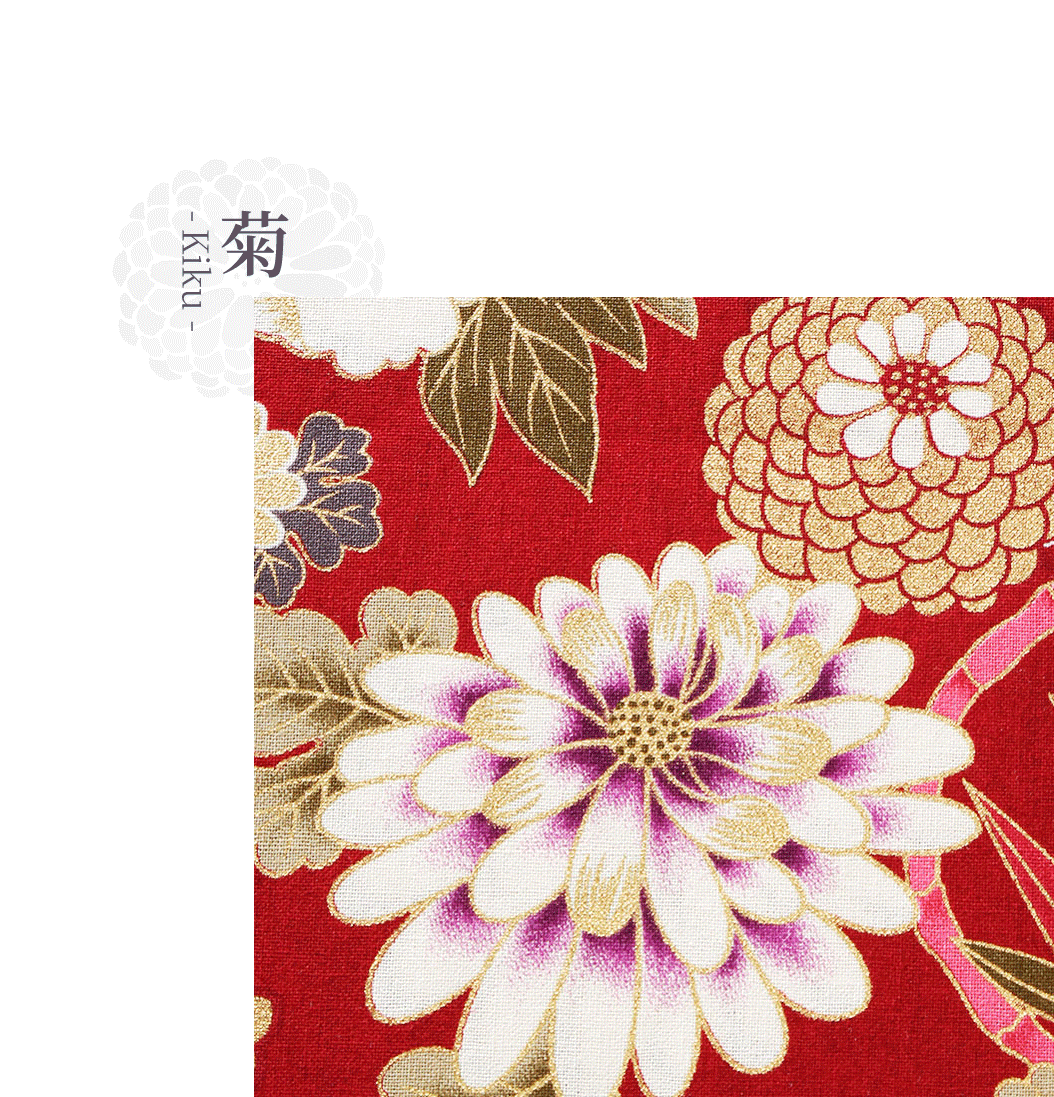
菊は皇室の御紋にも使われている日本を象徴する花の一つです。古くから「邪気を払う長寿の象徴」として信じられており、「延命長寿」「無病息災」「心身の安定」など健康面の願いが多く込められた柄です。菊の花言葉は「高貴」とあるように菊の柄はその圧倒的な華やかさと存在感です。その存在感を活かすには浴衣やエプロンなど面の広いアイテムに最適!他にはクッションカバーやテーブルランナー、生地をそのままパネルにして壁に飾るなどインテリアとして日常にアクセントをつけるのもオススメです! The chrysanthemum is one of the flowers that symbolize Japan and is also used in the Imperial family's crest. It has been believed to ward off evil spirits and is a symbol of longevity, health without illness, and mental and physical stability. As the flower language of the chrysanthemum is "nobility," the chrysanthemum pattern is overwhelmingly gorgeous and has a strong presence. To make the most of its presence, it is perfect for items with a large surface area such as yukatas and aprons. It's also recommended to use it as an accent in your daily life as interior decor, such as cushion covers, table runners, or even as a panel made from the fabric to hang on the wall!

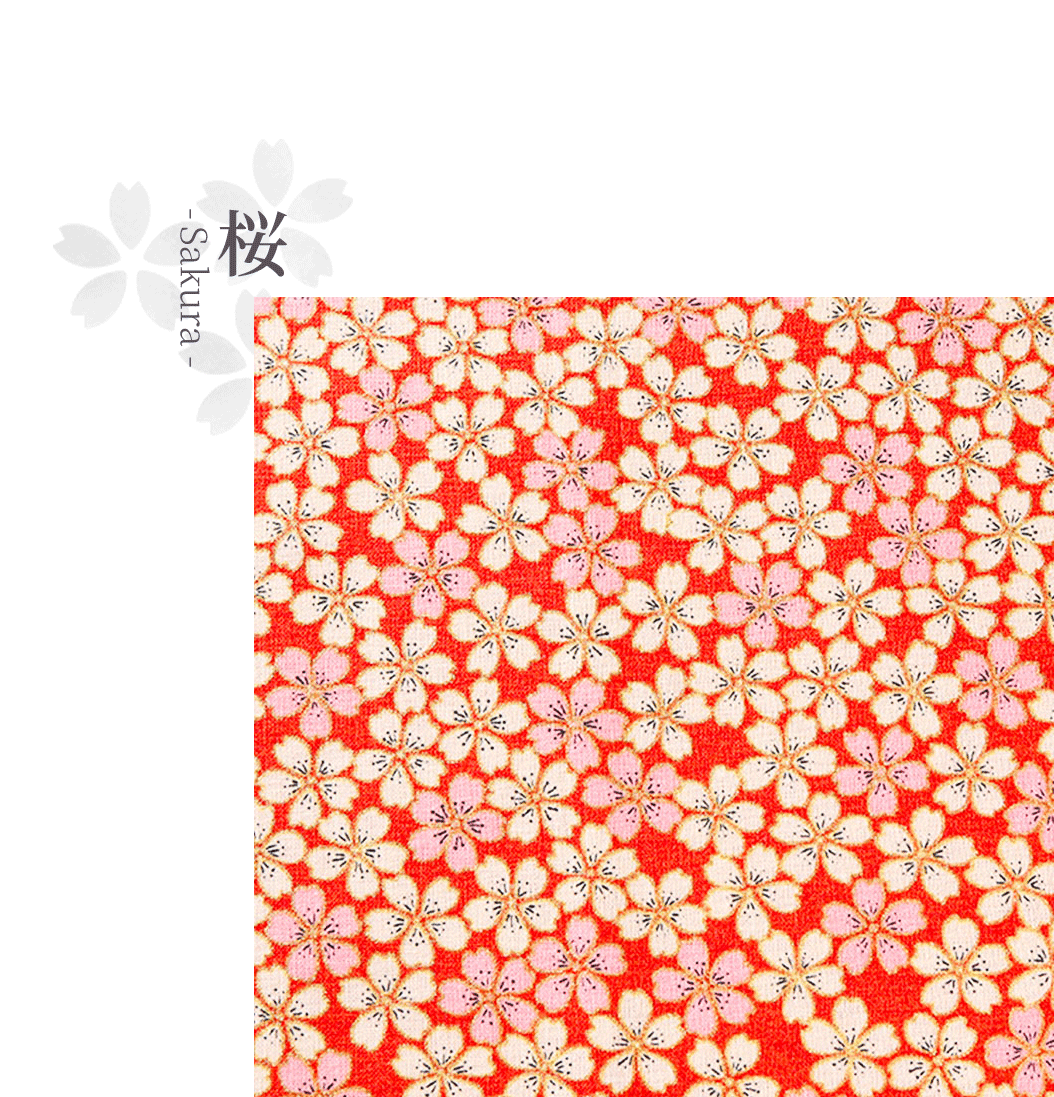
古くから愛されてきた日本を象徴する花、「桜」。毎年美しく咲き誇る姿から、「華やかさ」や「繁栄」を意味しています。また、桜の名前には「さ」=稲の神様、「くら(蔵)」=神様が宿るところという意味があることから桜柄は五穀豊穣を願い、新しい門出を祝う縁起の良い文様として伝えられています。桜柄は親しみがあり、大柄で桜メインの柄もあれば、さりげなく散りばめられた小柄の桜もあり、いろいろな表情を見せてくれます。大柄の桜は衣類のポイントに取り入れるのがおすすめ!小柄の桜にはポーチや巾着などの小物や食事に彩りを添えるランチョマットなどにするのも最適です♪
The cherry blossom, a flower that has been loved for centuries, symbolizes Japan. Its beautiful
and
full
bloom every year represents "glamor" and "prosperity." The name "sakura" also has the meanings
of
"sa" (the
god of rice fields) and "kura" (the place where gods dwell), making sakura patterns auspicious
motifs that
wish for a bountiful harvest and celebrate new beginnings. Cherry blossom patterns are familiar,
with large
patterns that feature cherry blossoms prominently, and small scattered cherry blossoms that
offer
various
expressions. Large cherry blossom patterns are recommended for use as highlights in clothing,
while
small
cherry blossom patterns are ideal for accessories such as pouches and drawstring bags, as well
as
placemats
to add color to meals.

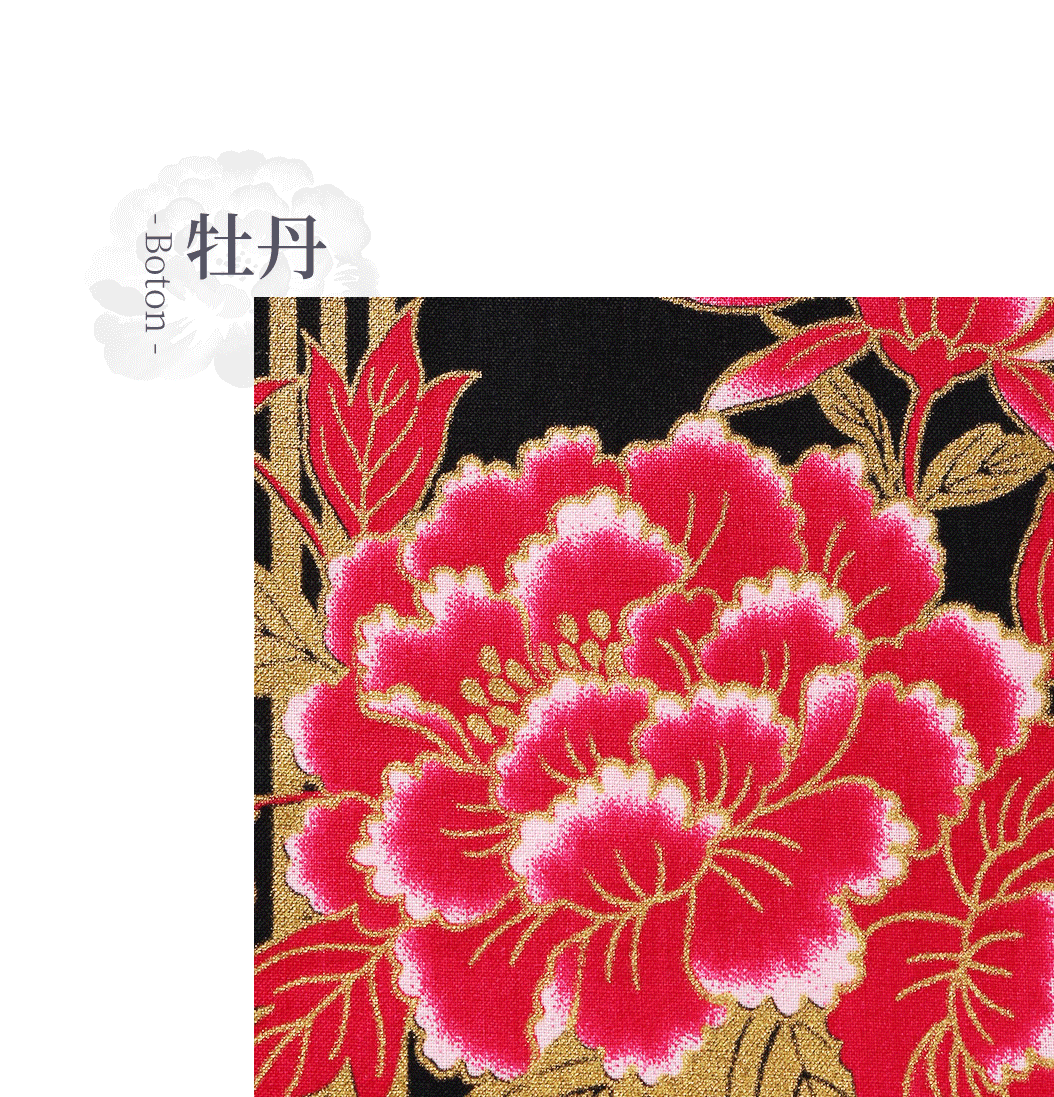
百花の王と呼ばれている牡丹は、美しく大きな花を毎年咲かせる豪華な花であり良い前兆の顕れとして、幸福や富貴の象徴とされていました。また牡丹の「丹」の字は不老不死の仙薬を表すことから「不老不死」「不老長寿」という意味もあります。昔から「立てば芍薬、座れば牡丹、歩く姿はユリの花」と表現されているように、牡丹は美しさを表現する花であり、美しく縁起の良い柄であるため晴れの日に着る柄としてとても愛されています。牡丹柄は大胆に描かれることが多いため、華やかな印象を残せる衣類やエプロン、またバッグなど面の広いアイテムに使用するのがおすすめの柄です。
Known as the king of a hundred flowers, the peony is a magnificent flower that blooms
beautifully
and
lavishly every year, symbolizing happiness and prosperity as a sign of good fortune. The
character
"丹" in
peony also represents the elixir of immortality, hence the meanings of "immortality" and
"eternal
youth."
Historically described as "standing as a peony, sitting as a peony, and walking as a lily," the
peony
represents beauty and is a well-loved auspicious pattern for wearing on special days. Peony
patterns
are
often boldly depicted, making them ideal for clothing, aprons, and bags, leaving a dazzling
impression.

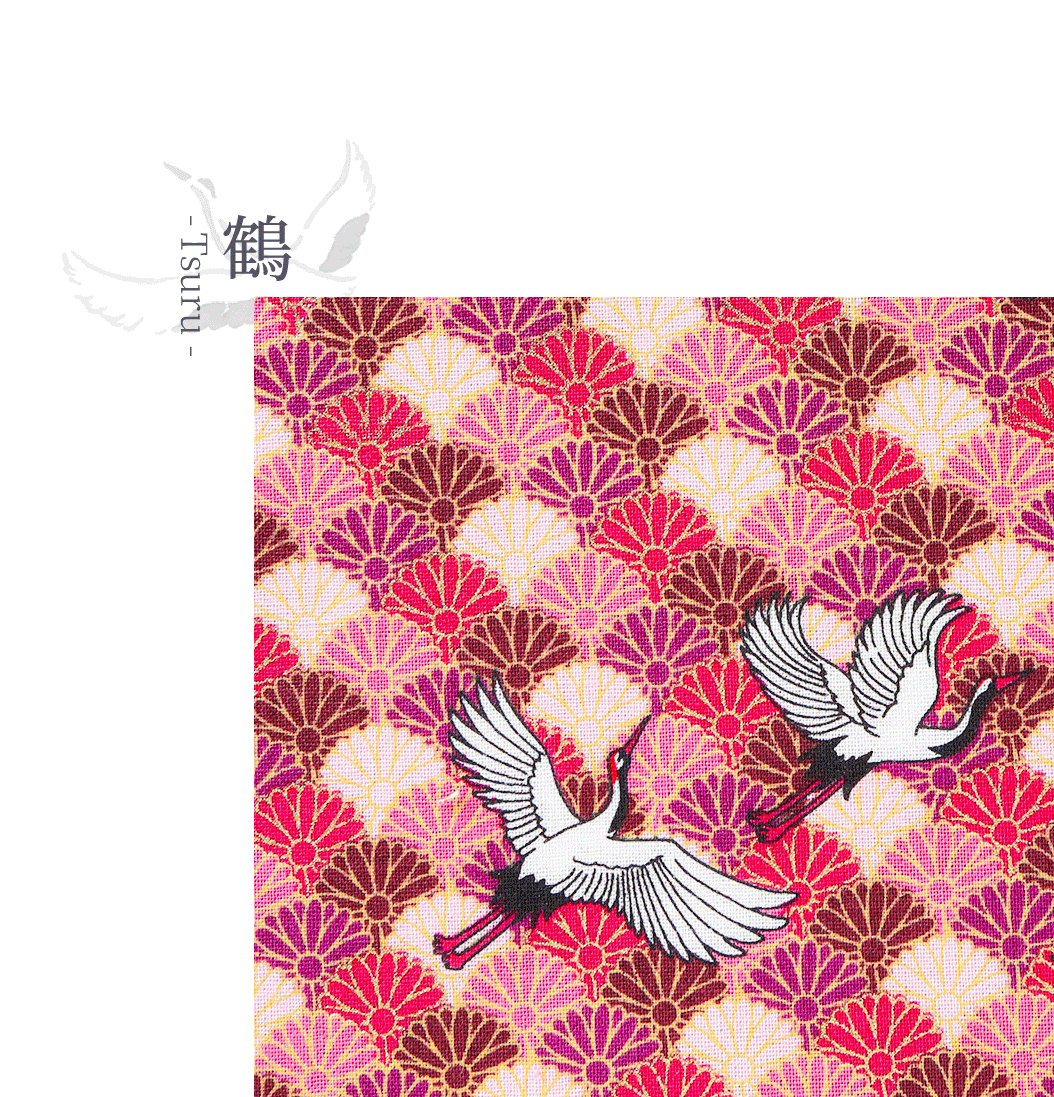
鶴の鳴き声は高く天まで届くとされ、神様と人間をつなぐありがたい存在と言われており、古来より長寿や生命力の強さの象徴です。また、鶴はつがいになると生涯相手を変えず一生添い遂げることから夫婦円満の意味も込められています。そのことから鶴の柄は婚礼の場など、おめでたい席によく使われています。鶴の柄には存在感があり、躍動感のある鶴もいれば、つい見ている人も微笑んでしまうような可愛らしい柄もあるので、ぜひお気に入りの鶴を見つけてほしいです。可愛らしい鶴には普段からよく使用するポーチや巾着に、存在感がある鶴にはシャツや浴衣などの衣服系や壁に飾ってインテリアの一部にしてもGOOD!
The crane's call is said to reach up to the heavens, making it a revered entity that connects
the
gods
and humans, symbolizing longevity and vitality since ancient times. Cranes are also known to
pair
for life,
symbolizing marital harmony. Because of this, crane patterns are often used in weddings and
other
celebratory occasions. Crane patterns have a strong presence, ranging from dynamic cranes to
adorable ones
that make viewers smile. Find your favorite crane pattern and incorporate it into frequently
used
items like
pouches and drawstring bags, or use more prominent crane patterns for shirts, yukatas, and as
interior decor
to enhance your living space.

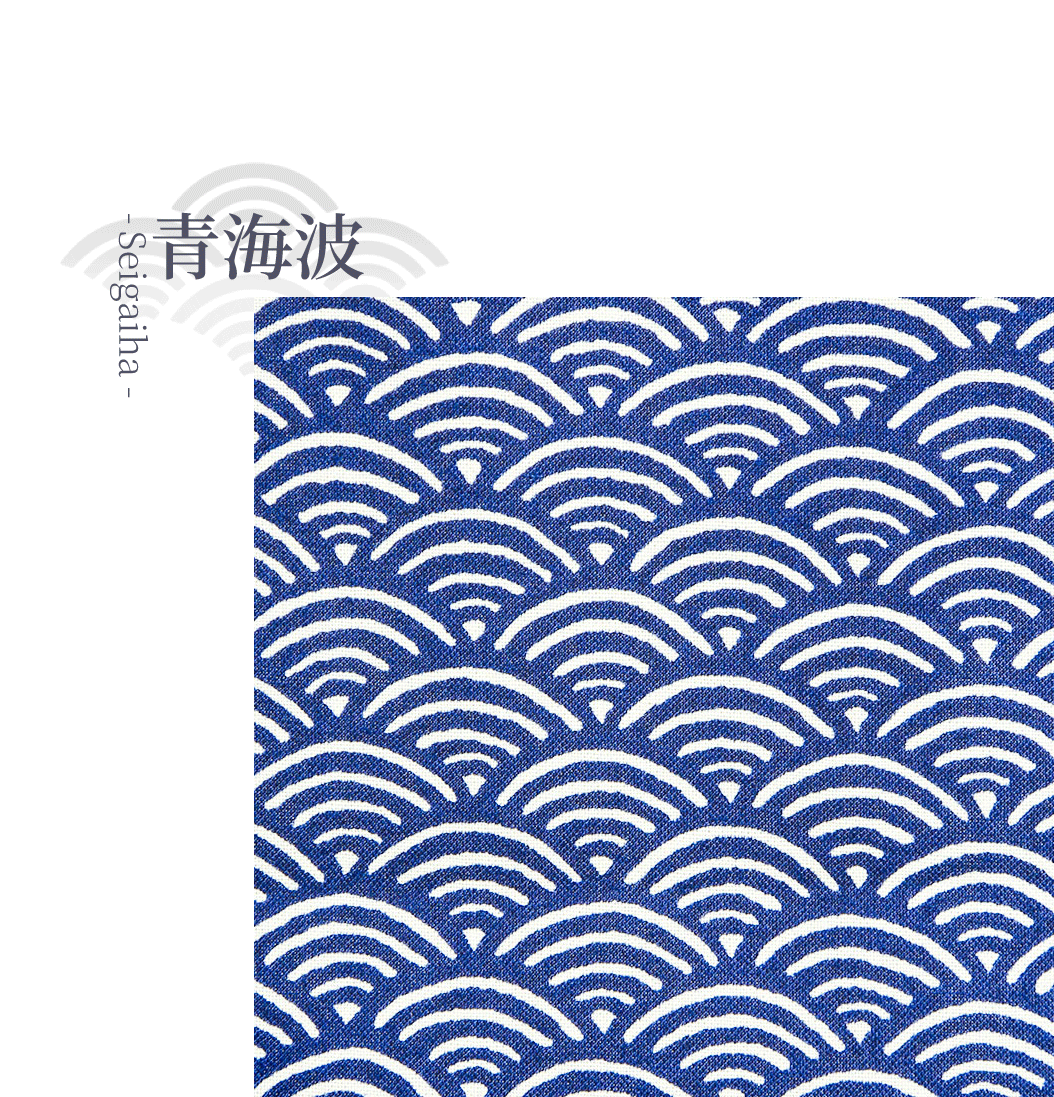
青海波は扇のような波が重なって描かれた柄です。この柄の発祥は古代ペルシャとされておりシルクロードを経て日本に伝わったとされています。“青海波”と呼ばれるようになったのは平安時代からですが衣装の柄としてよく用いられる様になったのは江戸時代中期からです。青海勘七(せいかんかんしち)という塗師が、青海波を巧みに描いたことから、この柄が広まりました。穏やかな波が無限に広がる波の文様に未来永劫へと続く幸せへの願いと人々の平安な暮らしへの願いが込められた縁起の良い柄です。そんな意味が込められていることから青海波の柄は結婚祝いや新築祝いに贈るのにおすすめの柄でもあります。
Seigaiha (青海波) is a pattern depicting overlapping fan-like waves. Originating in ancient Persia,
this
pattern was transmitted to Japan via the Silk Road. While it has been called "Seigaiha" since
the
Heian
period, it became commonly used as a pattern for clothing from the mid-Edo period. The craftsman
Seikan
Kanshichi popularized this pattern by skillfully depicting the Seigaiha. The pattern of calm,
infinitely
extending waves carries wishes for eternal happiness and peaceful lives, making it an auspicious
pattern.
Because of these connotations, Seigaiha is recommended for gifts celebrating weddings and new
homes.

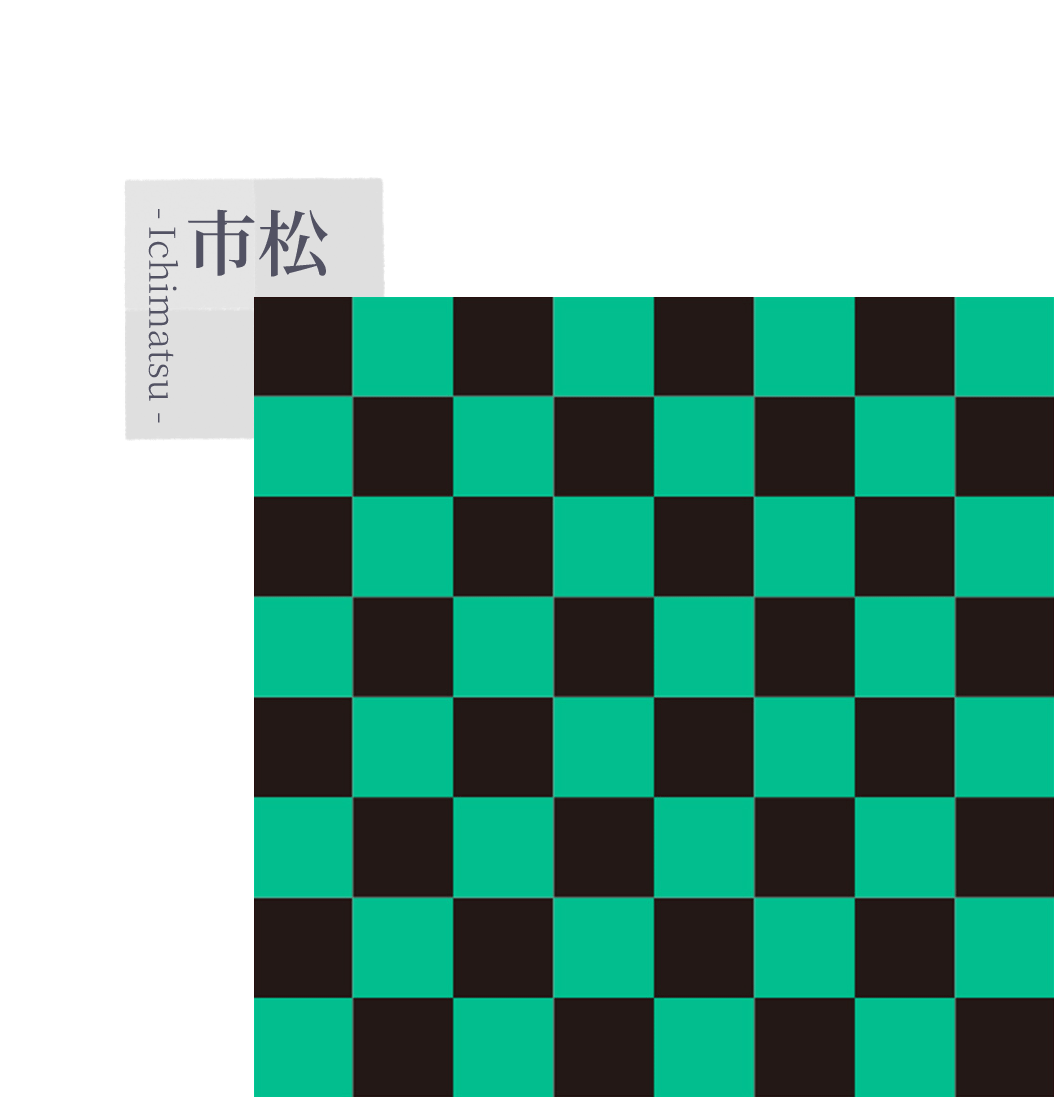
市松模様は、二色の正方形が交互に並んだ格子柄(チェック柄)のことを言います。江戸時代の二枚目歌舞伎役者の佐野川市松が舞台衣装で着用したところから女性人気に火がつき、市松模様と言われる様になりました。市松模様はその柄が途切れることなく続いて行くことから“繁栄”の意味が込められています。そこから子孫繁栄や事業拡大など運気上昇の願いを込めたプレゼントとして選ぶにふさわしい、縁起のよい柄です。近年ではあの有名な大人気アニメで主人公が着用している柄でもあり見たことがある人も多いかと思います。他には東京オリンピック・パラリンピックのエンブレムで市松模様が採用されたりと旬の柄でもあります。そんな市松模様は表現の幅が広く、色や正方形のサイズに決まりがないため組み合わせ次第でいろんな表情を見せてくれるのであらゆるアイテムに取り入れやすい柄と言えます。
The chequered pattern is a plaid pattern (chequered pattern) of alternating squares of two
different colours. The
chequered pattern became popular among women when it was worn as a stage costume by Sanogawa
Ichimatsu, a famous kabuki
actor of the Edo period (1603-1868), and it came to be known as the chequered pattern. The
chequered pattern has the
meaning of 'prosperity', as the pattern continues uninterrupted. The chequered pattern is
therefore an auspicious
pattern suitable as a present for wishing for prosperity of offspring and business expansion. In
recent years, many
people may have seen this pattern worn by the main character in a famous and popular animation.
The chequered pattern
was also used as the emblem for the Tokyo Olympics and Paralympics. The chequered pattern has a
wide range of
expression, and as there are no rules regarding the colours or the size of the squares, it can
be easily incorporated
into all kinds of items as it can show a variety of expressions depending on the combination.

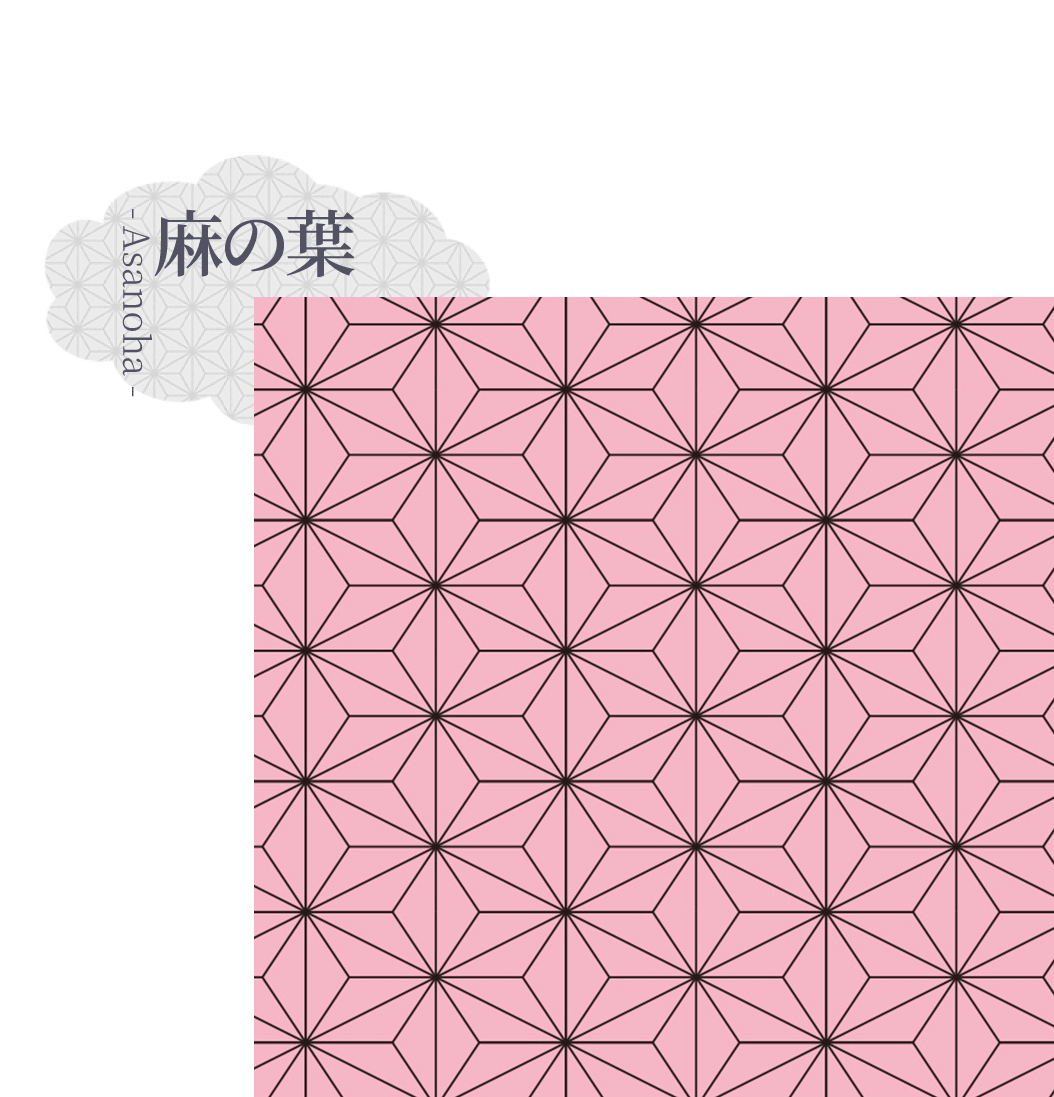
大人気アニメで主人公の妹が着用していた着物の柄としても有名な「麻の葉」柄。
麻の葉のモチーフを正六角形が幾何学的に結び付けられた柄です。麻は神事に用いられる神聖な植物とされていることや4ヶ月で4メートルにもなると言われており、成長の早さから「成長」「健康」を意味する模様です。江戸時代には、子供の成長を願い麻の葉文が描かれた産着を着せる魔除けの風習もありました。この柄はお子様やお孫様の健やかな成長を願い、子供服やお子様用の浴衣や甚平などご利用していただきたい柄です。
The hemp leaf pattern is also famous as the pattern of the kimono worn by the sister of the main
character in the
popular anime.
The pattern consists of regular hexagons geometrically tied together in a hemp leaf motif. The
hemp is considered a
sacred plant used in Shinto rituals and is said to grow up to four metres in four months, and
the pattern signifies
'growth' and 'health' due to its rapid growth. In the Edo period (1603-1868), it was customary
to wear a maternity gown
with a hemp leaf pattern on it to ward off evil spirits in the hope that the child would grow
up. This pattern should be
used for children's clothing, children's yukata and jinbei, etc., to wish for the healthy growth
of children and
grandchildren.

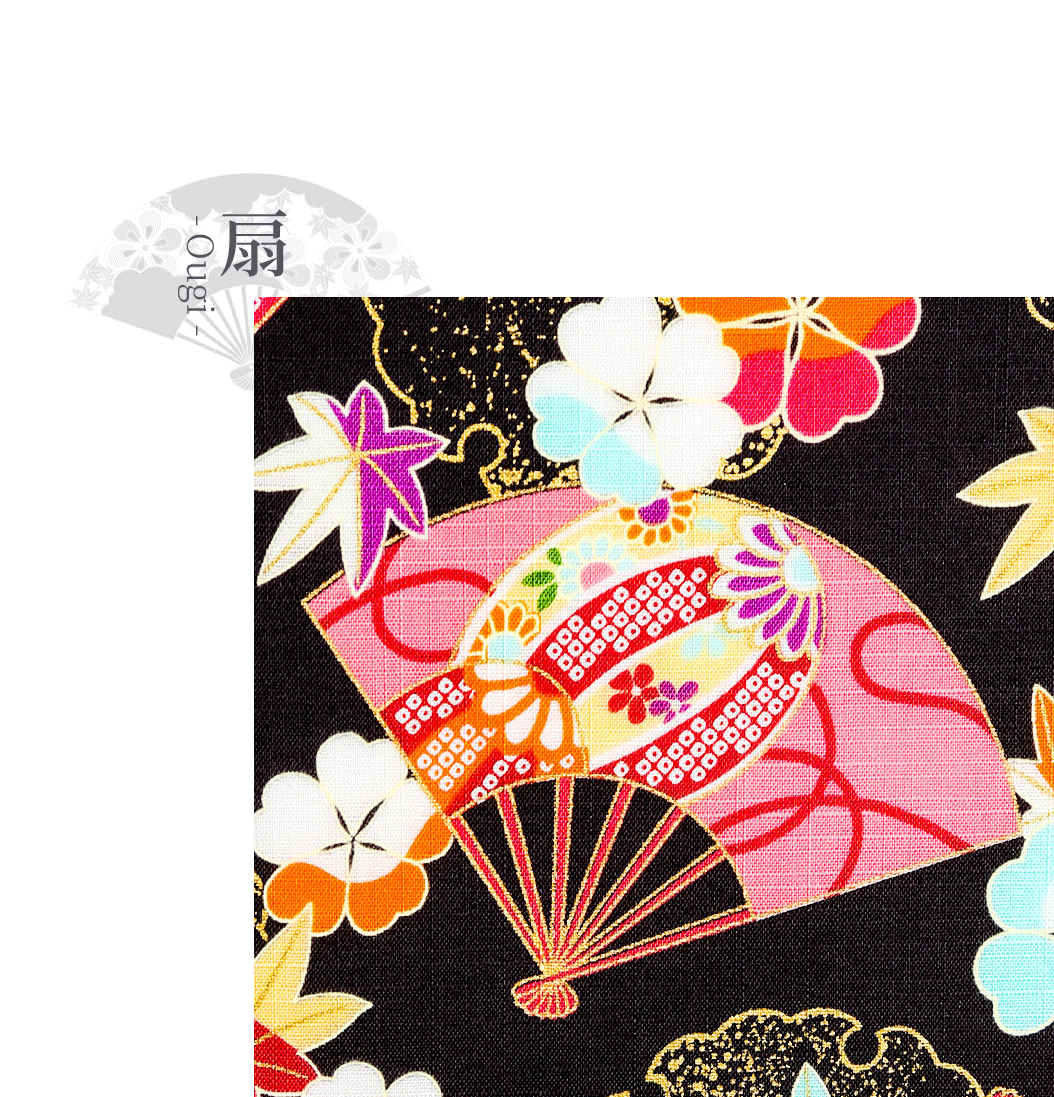
扇は日本で考案されたもので、広げると先端が広がった末広がりの形をしていることから、未来への展望が明るいという意味があります。「開運招福」のご利益があることから結婚やお祝い事に相応しい縁起の良い柄として知られています。そんな扇柄は開いているものや半開きにしたもの、また扇子の柄も多様なデザインで描かれているため印象がガラリと変わるのも特徴の一つです。可愛いものから高級感のある上品な柄もあるので必ず欲しい扇子柄が見つかることでしょう。開運招福のご利益があるのでプレゼントに使うも良し、自身の開運を願って扇柄を取り入れたアイテムを作るもおすすめ!
The fan, invented in Japan, has a shape that spreads outwards, symbolizing a bright future. It
is
known
as an auspicious pattern suitable for weddings and celebratory occasions due to its blessings of
"good luck
and fortune." Fan patterns vary greatly in design, with open fans, half-open fans, and various
designs
depicted on them, giving each a unique impression. From cute designs to elegant and luxurious
ones,
you're
sure to find a fan pattern you love. It's perfect for gifts wishing for good luck or
incorporating
fan
patterns into items for your own good fortune.

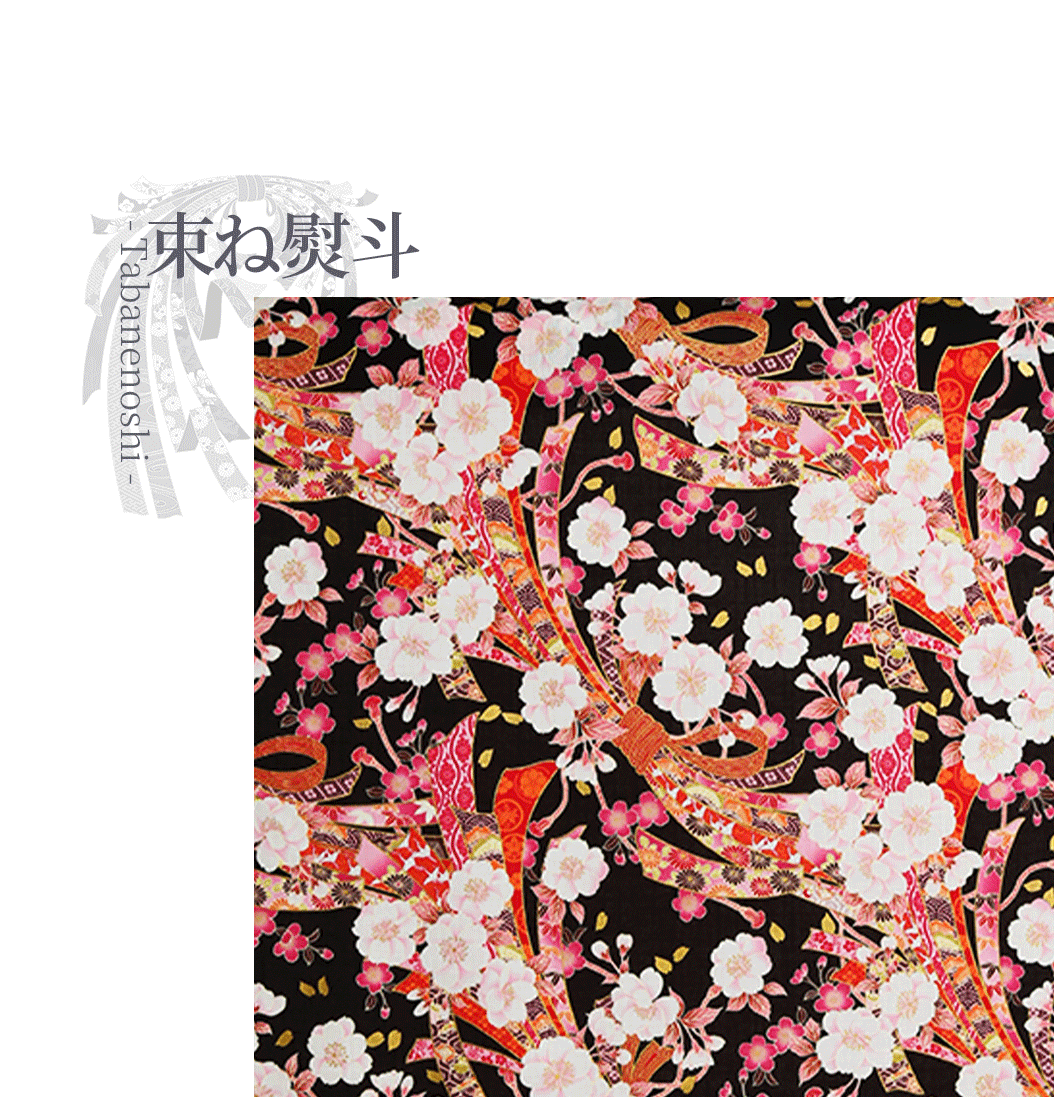
細長く帯状にした複数の熨斗(のし)を束ねた模様です。贈り物の華やかさや高級感を表す熨斗を複数束ねた様子から「多くの人から祝福されていること」「人と人とのつながりや絆」を表します。また、熨斗の長さは「長寿」の象徴とも言われており、お祝い事の式服やお宮参りの着物にもよく使われるおめでたい模様です。リボンのようにも見える柄で、熨斗の柄によっても印象が変わります。ぜひ束ね熨斗を目立たせる浴衣やエプロンなどの衣装やクッションカバーなどにおすすめです。
Tabane Noshi (束ね熨斗) is a pattern that bundles multiple Noshi (thin, long strips of paper or
cloth)
together. This symbolizes "being blessed by many people" and "connections and bonds between
people,"
representing the elegance and luxury of gifts. The length of Noshi also symbolizes "longevity,"
making this
an auspicious pattern often used in formal celebratory attire and Miyamairi (a traditional
Shinto
rite of
passage for newborns). The pattern can resemble ribbons, with different impressions depending on
the
Noshi's
design. It is recommended for items that highlight the Tabane Noshi pattern, such as yukatas,
aprons, or
cushion covers.

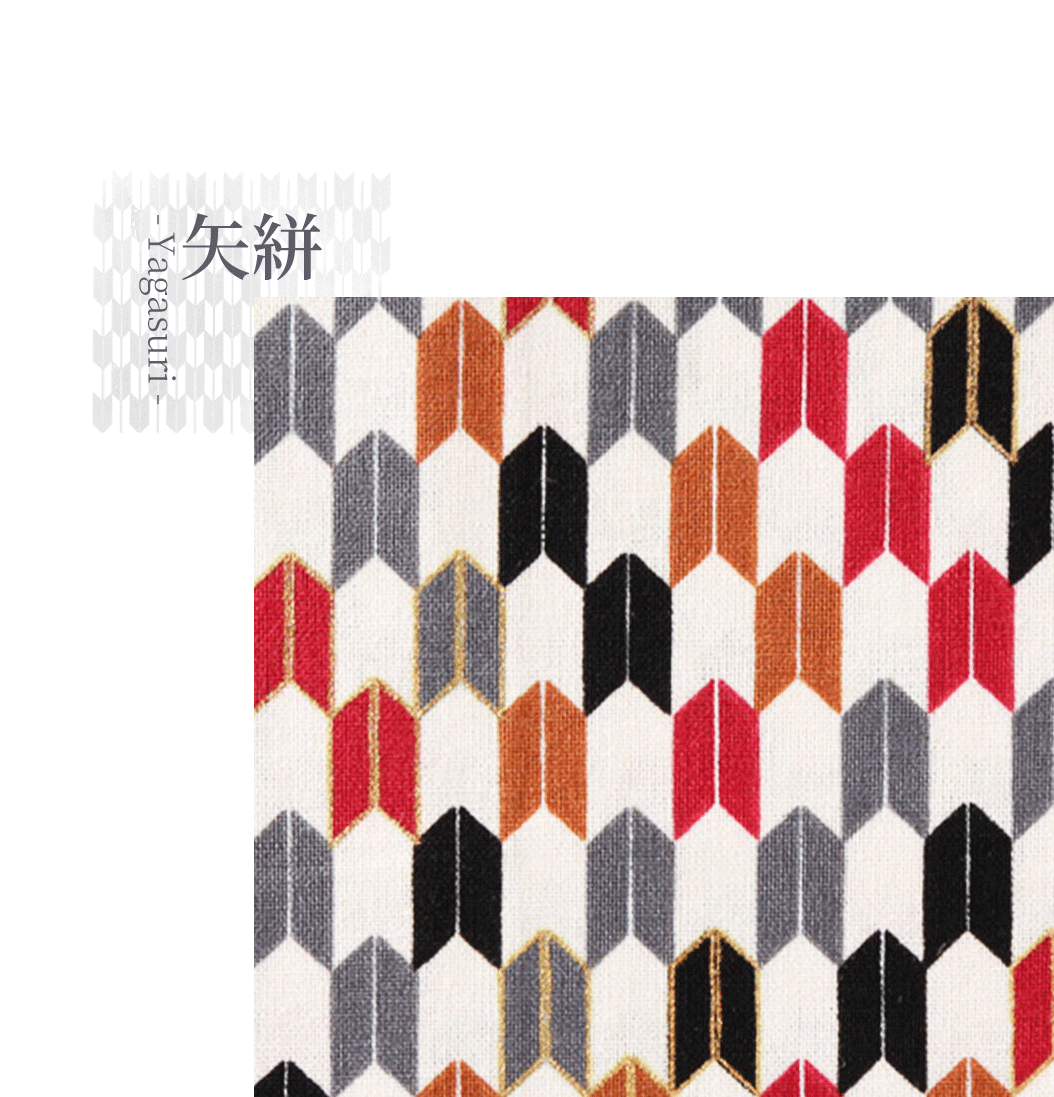
矢の羽をモチーフにしており、「的を射る」「まっすぐ進む」ことから縁起物として使われている柄です。また、矢は一度放たれると戻ってこないことから、江戸時代には「出戻らないように」嫁入り道具に矢絣の着物を持たせるといった風習がありました。明治時代になると袴が女学生の制服となり、大正時代にかけて数多くの女学生が矢絣の着物を袴に合わせ着用したことで、学生服の定番となりました。今でも卒業式に着る袴の人気柄の一つです。絣のデザインは矢羽根が一方向を向いているもの、一列ごとに方向が違うもの、花柄をあしらったものなど、そのバリエーションも豊富で柄のサイズも大きすぎないものもあるので小物入れやブックカバーなどにも使いやすい柄となっています。
The Yagasuri pattern, inspired by arrow feathers, symbolizes "hitting the target" and "moving
straight
forward," making it an auspicious pattern. Additionally, because an arrow does not return once
shot,
during
the Edo period, there was a custom of including Yagasuri-patterned kimonos in a bride's
trousseau to
symbolize not returning to the parental home. In the Meiji period, hakama became the uniform for
female
students, and many students wore Yagasuri-patterned kimonos with hakama, making it a staple of
student
attire through the Taisho period. It remains a popular pattern for graduation ceremonies today.
The
Yagasuri
design comes in various forms, with arrow feathers pointing in one direction, alternating
directions, or
incorporating floral patterns. This variety, along with the moderate size of the patterns, makes
it
suitable
for items like small pouches or book covers.